Degradation Kinetics of Automotive Shredder Residue and Waste Automotive Glass for SiC Synthesis: An Energy-Efficient Approach
Abstract
:1. Introduction
2. Experimental Method
2.1. Materials
2.2. Sample Preparation
2.3. Characterisation
2.4. Kinetic Study
2.5. Formation Mechanism of SiC
3. Results and Discussion
3.1. Characterisation of Heat-Treated Products
XRD Spectrums of Heat-Treated ASR and Waste Glass Mixture
3.2. Kinetics of Degradation
3.2.1. Non-Isothermal Condition
3.2.2. Isothermal Degradation
3.2.3. Temperature Dependence of Initial Linear Rate Constant
4. Conclusions
Supplementary Materials
Author Contributions
Funding
Data Availability Statement
Acknowledgments
Conflicts of Interest
References
- Aarnæs, T.S.; Tangstad, M.; Ringdalen, E. SiC formation and SiO reactivity of methane at high temperatures. Mater. Chem. Phys. 2022, 276, 125355. [Google Scholar] [CrossRef]
- Li, F.; Tangstad, M. Carbothermal reduction of quartz with carbon from natural gas. Met. Mater. Trans. B 2017, 48, 853–869. [Google Scholar] [CrossRef]
- Li, F.; Tangstad, M.; Ringdalen, E. Carbothermal reduction of quartz and carbon pellets at elevated temperatures. Met. Mater. Trans. B 2018, 49, 1078–1088. [Google Scholar] [CrossRef]
- Schei, A.; Tuset, J.K.; Tveit, H. Production of High Silicon Alloys; Tapir: Trondheim, Norway, 1998. [Google Scholar]
- Kumar, P.V.; Gupta, G.S. Study of formation of silicon carbide in the Acheson process. Steel Res. 2002, 73, 31–38. [Google Scholar] [CrossRef]
- Ramrakhiani, M. Nanostructures and their applications. Recent Res. Sci. Technol. 2012, 4, 14–19. [Google Scholar]
- Castelletto, S.; Johnson, B.C.; Boretti, A. Quantum effects in silicon carbide hold promise for novel integrated devices and sensors. Adv. Opt. Mater. 2013, 1, 609–625. [Google Scholar] [CrossRef]
- Chan, W.C.; Nie, S. Quantum dot bioconjugates for ultrasensitive nonisotopic detection. Science 1998, 281, 2016–2018. [Google Scholar] [CrossRef] [Green Version]
- Bruchez, M.; Moronne, M.; Gin, P.; Weiss, S.; Alivisatos, A.P. Semiconductor nanocrystals as fluorescent biological labels. Science 1998, 281, 2013–2016. [Google Scholar] [CrossRef] [Green Version]
- Phan, H.-P.; Dao, D.V.; Nakamura, K.; Dimitrijev, S.; Nguyen, N.-T. The piezoresistive effect of SiC for MEMS sensors at high temperatures: A review. J. Microelectromechanical Syst. 2015, 24, 1663–1677. [Google Scholar] [CrossRef] [Green Version]
- Ziegler, G.; Lanig, P.; Theis, D.; Weyrich, C. Single crystal growth of SiC substrate material for blue light emitting diodes. IEEE Trans. Electron Devices 1983, 30, 277–281. [Google Scholar] [CrossRef]
- Wright, N.G.; Horsfall, A.B.; Vassilevski, K. Prospects for SiC electronics and sensors. Mater. Today 2008, 11, 16–21. [Google Scholar] [CrossRef]
- Oliveros, A.; Guiseppi-Elie, A.; Saddow, S.E. Silicon carbide: A versatile material for biosensor applications. Biomed. Microdevices 2013, 15, 353–368. [Google Scholar] [CrossRef] [PubMed]
- Hatakeyama, F.; Kanzaki, S. Synthesis of Monodispersed Spherical β-Silicon Carbide Powder by a Sol-Gel Process. J. Am. Ceram. Soc. 1990, 73, 2107–2110. [Google Scholar] [CrossRef]
- Seog, I.-S.; Kim, C.H. Preparation of monodispersed spherical silicon carbide by the sol-gel method. J. Mater. Sci. 1993, 28, 3277–3282. [Google Scholar] [CrossRef]
- Qian, J.-M.; Wang, J.-P.; Qiao, G.-J.; Jin, Z.-H. Preparation of porous SiC ceramic with a woodlike microstructure by sol-gel and carbothermal reduction processing. J. Eur. Ceram. Soc. 2004, 24, 3251–3259. [Google Scholar] [CrossRef]
- Guo, J.; Zuo, Y.; Li, Z.; Gao, W.; Zhang, J. Nanostructures. Preparation of SiC nanowires with fins by chemical vapor deposition. Phys. E Low-Dimens. Syst. Nanostructures 2007, 39, 262–266. [Google Scholar] [CrossRef]
- Henderson, E.J.; Veinot, J.G. From phenylsiloxane polymer composition to size-controlled silicon carbide nanocrystals. J. Am. Chem. Soc. 2009, 131, 809–815. [Google Scholar] [CrossRef]
- Zhu, C.; Zhao, G.; Revankar, V.; Hlavacek, V. Synthesis of ultra-fine SiC powders in a dc plasma reactor. J. Mater. Sci. 1993, 28, 659–668. [Google Scholar] [CrossRef]
- Guo, J.; Gitzhofer, F.; Boulos, M.I. Induction plasma synthesis of ultrafine SiC powders from silicon and CH4. J. Mater. Sci. 1995, 30, 5589–5599. [Google Scholar] [CrossRef]
- Ramesh, P.; Vaidhyanathan, B.; Ganguli, M.; Rao, K.J. Synthesis of β-SiC powder by use of microwave radiation. J. Mater. Res. 1994, 9, 3025–3027. [Google Scholar] [CrossRef]
- Farzana, R.; Sahajwalla, V. Novel recycling to transform automotive waste glass and plastics into SiC-bearing resource by silica reduction. J. Sustain. Metall. 2015, 1, 65–74. [Google Scholar] [CrossRef] [Green Version]
- Rajarao, R.; Farzana, R.; Khanna, R.; Sahajwalla, V. Synthesis of SiC/Si3N4 nanocomposite by using automotive waste tyres as resource. J. Ind. Eng. Chem. 2015, 29, 35–38. [Google Scholar] [CrossRef]
- Mayyas, M.; Pahlevani, F.; Handoko, W.; Sahajwalla, V. Preliminary investigation on the thermal conversion of automotive shredder residue into value-added products: Graphitic carbon and nano-ceramics. Waste Manag. 2016, 50, 173–183. [Google Scholar] [CrossRef] [PubMed]
- Maroufi, S.; Mayyas, M.; Sahajwalla, V. Waste materials conversion into mesoporous silicon carbide nanocermics: Nanofibre/particle mixture. J. Clean. Prod. 2017, 157, 213–221. [Google Scholar] [CrossRef]
- Hossain, R.; Sahajwalla, V. Molecular recycling: A key approach to tailor the waste recycling for high-value nano silicon carbide. J. Clean. Prod. 2021, 316, 128344. [Google Scholar] [CrossRef]
- Jody, B.; Daniels, E.; Duranceau, C.; Pomykala, J.; Spangenberger, J. End-of-Life Vehicle Recycling: State of the Art of Resource Recovery from Shredder Residue; Argonne National Lab (ANL): Argonne, IL, USA, 2011. [Google Scholar]
- GHK; Bio Intelligence Service. A Study to Examine the Benefits of the End of Life Vehicles Directive and the Costs and Benefits of a Revision of the 2015 Targets for Recycling, Re-Use and Recovery under the ELV Directive; DG Environment: Birmingham, AL, USA, 2006. [Google Scholar]
- Cossu, R.; Lai, T. Automotive shredder residue (ASR) management: An overview. Waste Manag. 2015, 45, 143–151. [Google Scholar] [CrossRef]
- Patierno, O.; Cipriani, P.; Pochetti, F.; Giona, M. Pyrolysis of automotive shredder residues: A lumped kinetic characterization. Chem. Eng. J. 1998, 70, 157–163. [Google Scholar] [CrossRef]
- Hemati, S.; Hossain, R.; Sahajwalla, V. Selective thermal transformation of automotive shredder residues into high-value nano silicon carbide. Nanomaterials 2021, 11, 2781. [Google Scholar] [CrossRef] [PubMed]
- Lee, J.-S.; Byeun, Y.-K.; Lee, S.-H.; Choi, S.-C. In situ growth of SiC nanowires by carbothermal reduction using a mixture of low-purity SiO2 and carbon. J. Alloys Compd. 2008, 456, 257–263. [Google Scholar] [CrossRef]
- Omoriyekomwan, J.E.; Tahmasebi, A.; Dou, J.; Tian, L.; Yu, J. Mechanistic study on the formation of silicon carbide nanowhiskers from biomass cellulose char under microwave. Mater. Chem. Phys. 2021, 262, 124288. [Google Scholar] [CrossRef]
- Mayyas, M.; Pahlevani, F.; Maroufi, S.; Liu, Z.; Sahajwalla, V. Waste conversion into high-value ceramics: Carbothermal nitridation synthesis of titanium nitride nanoparticles using automotive shredder waste. J. Environ. Manag. 2017, 188, 32–42. [Google Scholar] [CrossRef] [PubMed]
- Long, Q.; Wang, C. Thermal Degradation Behavior and Kinetics Analysis of PMMA with Different Carbon Black Contents. Chin. J. Mater. Res. 2022, 36, 837–844. [Google Scholar]
- Xu, J.; Zuo, H.; Wang, G.; Zhang, J.; Guo, K.; Liang, W. Gasification mechanism and kinetics analysis of coke using distributed activation energy model (DAEM). Appl. Therm. Eng. 2019, 152, 605–614. [Google Scholar] [CrossRef]
- Yao, Z.; Yu, S.; Su, W.; Wu, W.; Tang, J.; Qi, W. Kinetic studies on the pyrolysis of plastic waste using a combination of model-fitting and model-free methods. Waste Manag. Res. 2020, 38, 77–85. [Google Scholar] [CrossRef] [PubMed]
- Cai, J.; Bi, L. Precision of the Coats and Redfern method for the determination of the activation energy without neglecting the low-temperature end of the temperature integral. Energy Fuels 2008, 22, 2172–2174. [Google Scholar] [CrossRef]
- Mayyas, M.; Mayyas, M.; Pahlevani, F.; Liu, Z.; Rajarao, R.; Sahajwalla, V. From automotive shredder residue to nano-ceramics and graphitic carbon—Thermal degradation kinetics. J. Anal. Appl. Pyrolysis 2016, 120, 60–74. [Google Scholar] [CrossRef]
- Abolpour, B.; Shamsoddini, R. Mechanism of reaction of silica and carbon for producing silicon carbide. Prog. React. Kinet. Mech. 2020, 45, 1468678319891416. [Google Scholar] [CrossRef] [Green Version]
- Crapse, J.; Pappireddi, N.; Gupta, M.; Shvartsman, S.Y.; Wieschaus, E.; Wühr, M. Evaluating the Arrhenius equation for developmental processes. Mol. Syst. Biol. 2021, 17, e9895. [Google Scholar] [CrossRef]
- Carroll, D.F.; Weimer, A.W.; Dunmead, S.D.; Eisman, G.A.; Hwang, J.H.; Cochran, G.A.; Susnitzky, D.W.; Beaman, D.R.; Conner, C.L. Carbothermally prepared nanophase SiC/Si3N4 composite powders and densified parts. AIChE J. 1997, 43, 2624–2635. [Google Scholar] [CrossRef]
- Viscomi, F.; Himmel, L. Kinetic and mechanistic study on the formation of silicon carbide from silica flour and coke breeze. JOM 1978, 30, 21–24. [Google Scholar] [CrossRef]
- Zhang, Y.; Shi, E.-W.; Chen, Z.-Z.; Li, X.-B.; Xiao, B. Large-scale fabrication of silicon carbide hollow spheres. J. Mater. Chem. 2006, 16, 4141–4145. [Google Scholar] [CrossRef]
- Han, S.; Jang, Y.-C.; Choi, Y.-S.; Choi, S.-K. Thermogravimetric kinetic study of automobile shredder residue (ASR) pyrolysis. Energies 2020, 13, 1451. [Google Scholar] [CrossRef] [Green Version]
- Krishnarao, R.V.; Godkhindi, M.M. Studies on the formation of SiC whiskers from pulverized rice husk ashes. Ceram. Int. 1992, 18, 35–42. [Google Scholar] [CrossRef]
- Choi, H.-J.; Lee, J.-G. Continuous synthesis of silicon carbide whiskers. J. Mater. Sci. 1995, 30, 1982–1986. [Google Scholar] [CrossRef]
- Laidler, K.J. The development of the Arrhenius equation. J. Chem. Educ. 1984, 61, 494. [Google Scholar] [CrossRef]
- Lee, J.G. Formation of silicon carbide from rice hulls. Am. Ceram. Soc. Bull. 1975, 54, 195–198. [Google Scholar]
- Weimer, A.W.; Nilsen, K.J.; Cochran, G.A.; Roach, R.P. Kinetics of carbothermal reduction synthesis of beta silicon carbide. AIChE J. 1993, 39, 493–503. [Google Scholar] [CrossRef]
- Blumenthal, J.L.; Santy, M.J.; Burns, E.A. Kinetic studies of high-temperature carbon-silica reactions in charred silica-reinforced phenolic resins. AIAA J. 1966, 4, 1053–1057. [Google Scholar] [CrossRef]
- Kuznetsova, V.; Dmitrenko, V.; Kokurin, A. Kinetics of formation of silicon carbide. Proc. Mendeleev Chem. Soc. 1980, 25, 118–119. [Google Scholar]
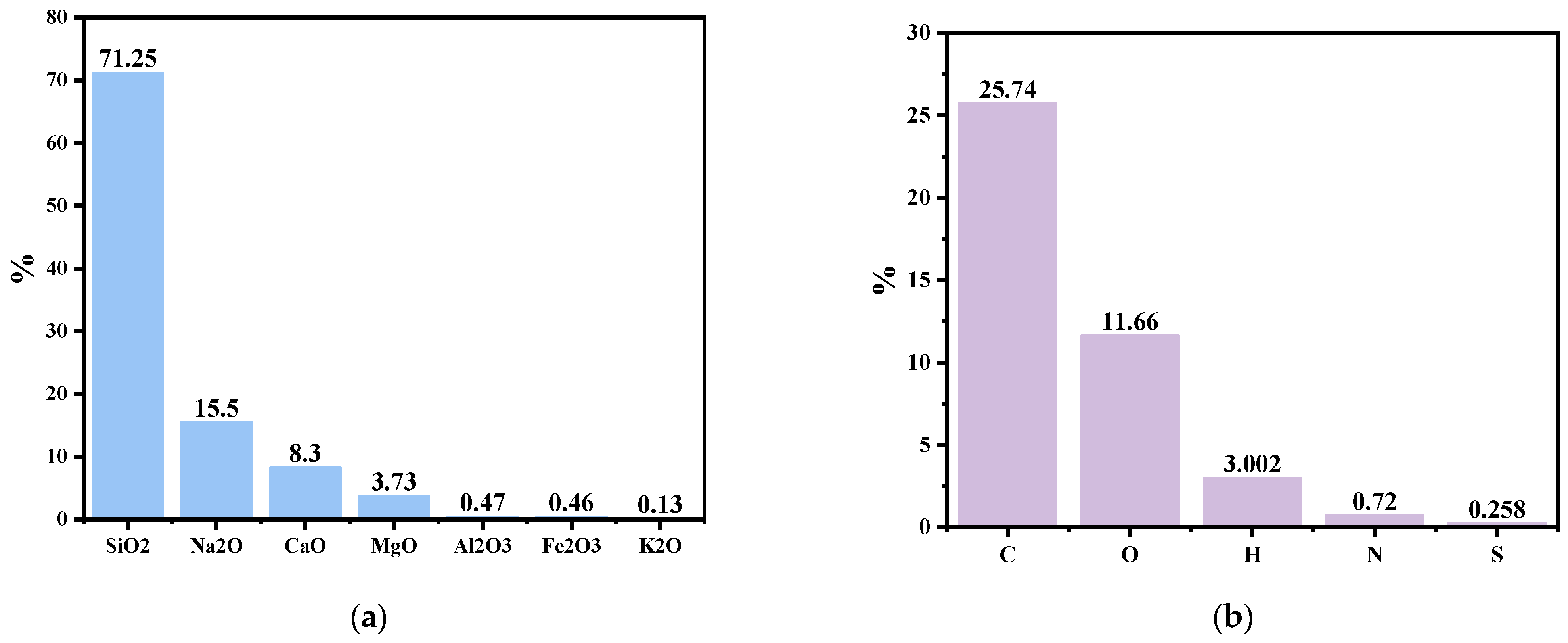


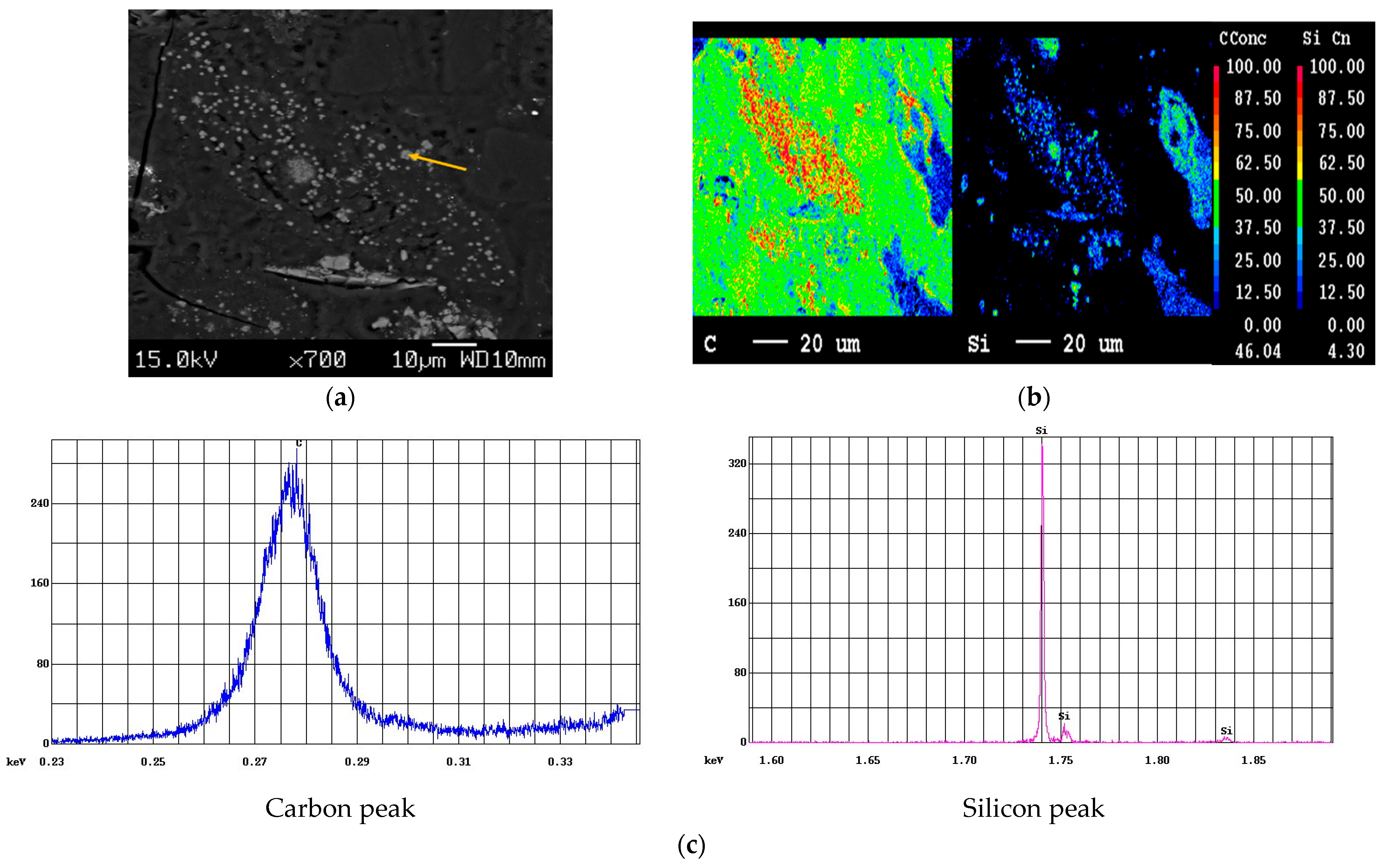
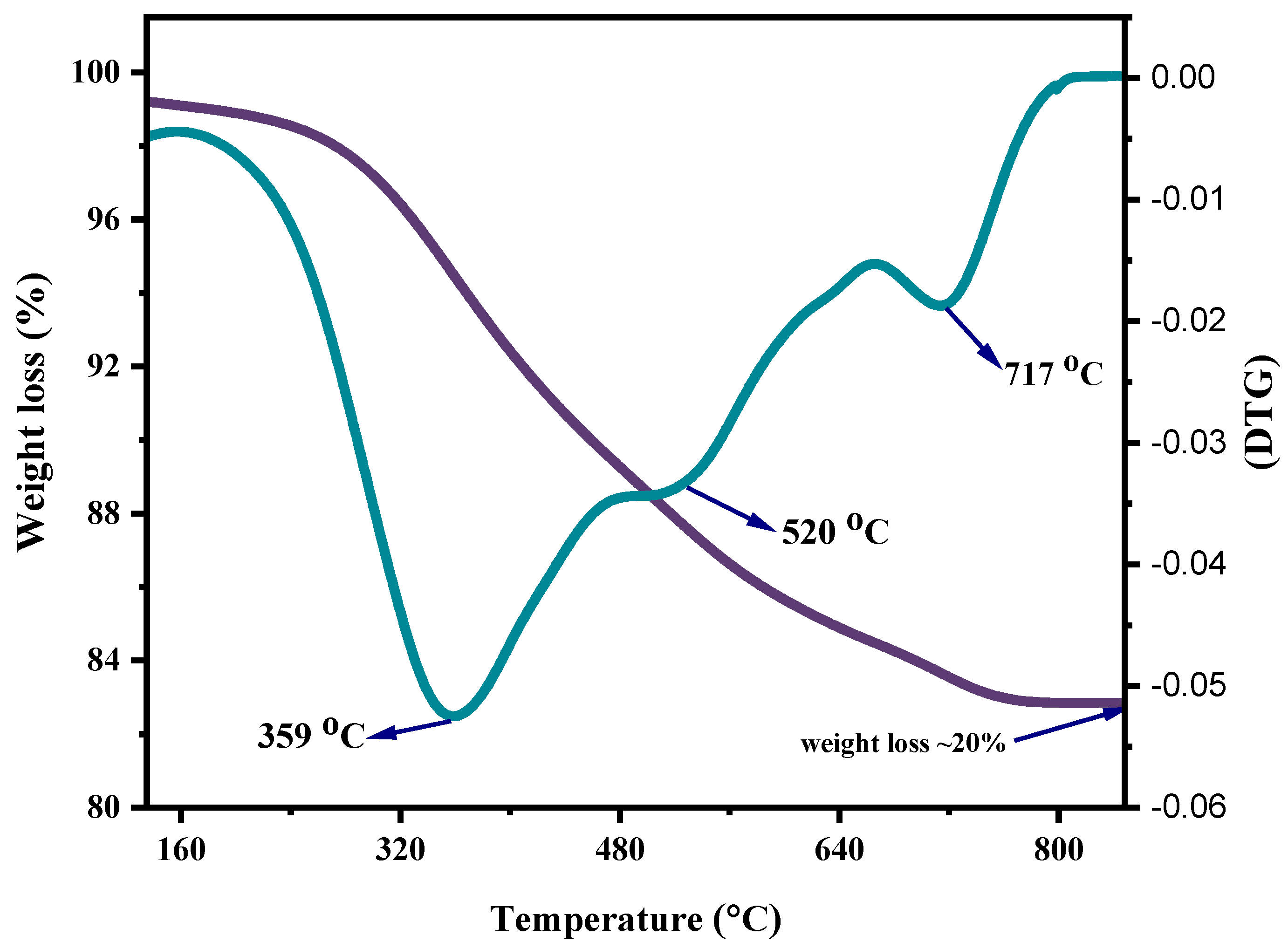

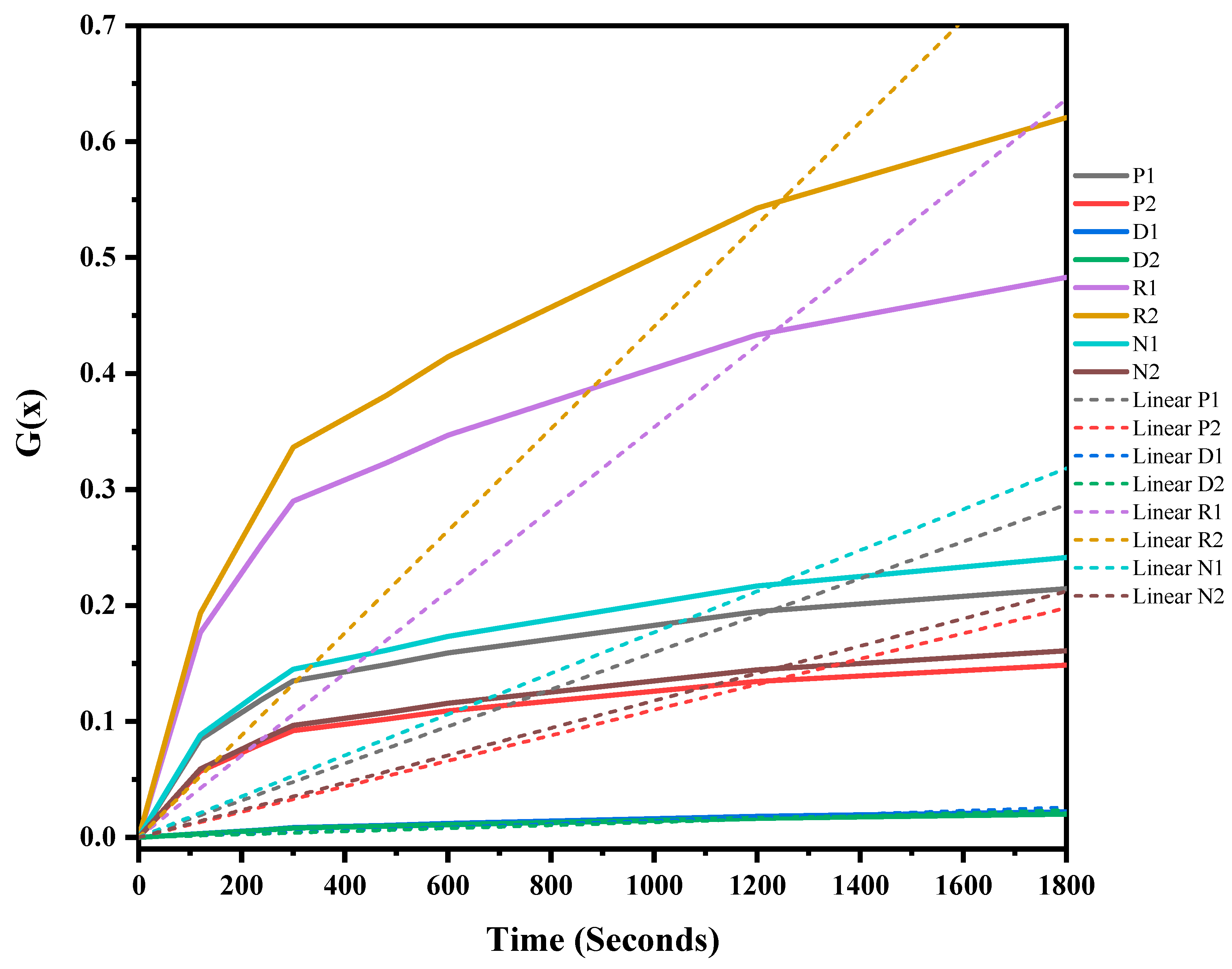
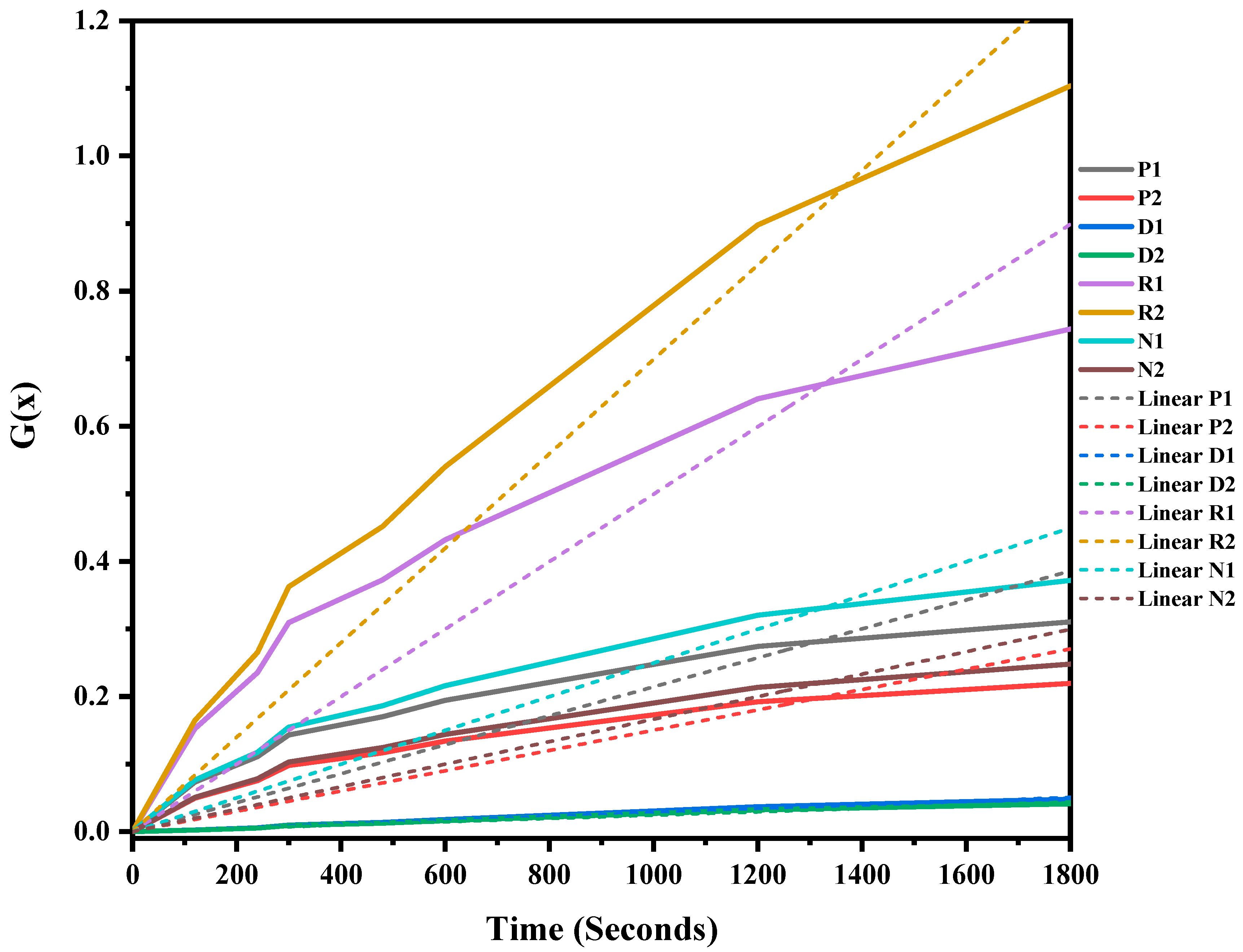
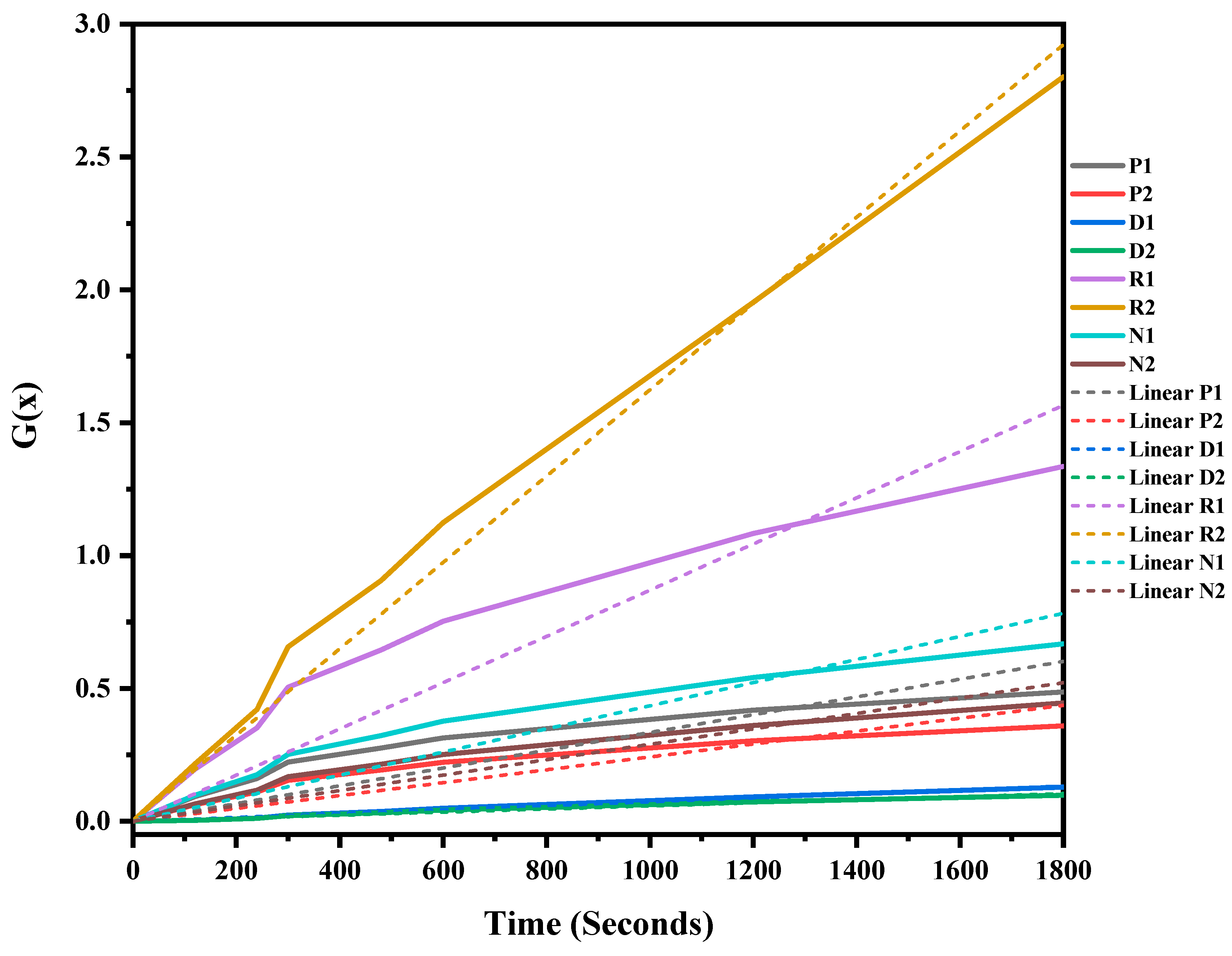
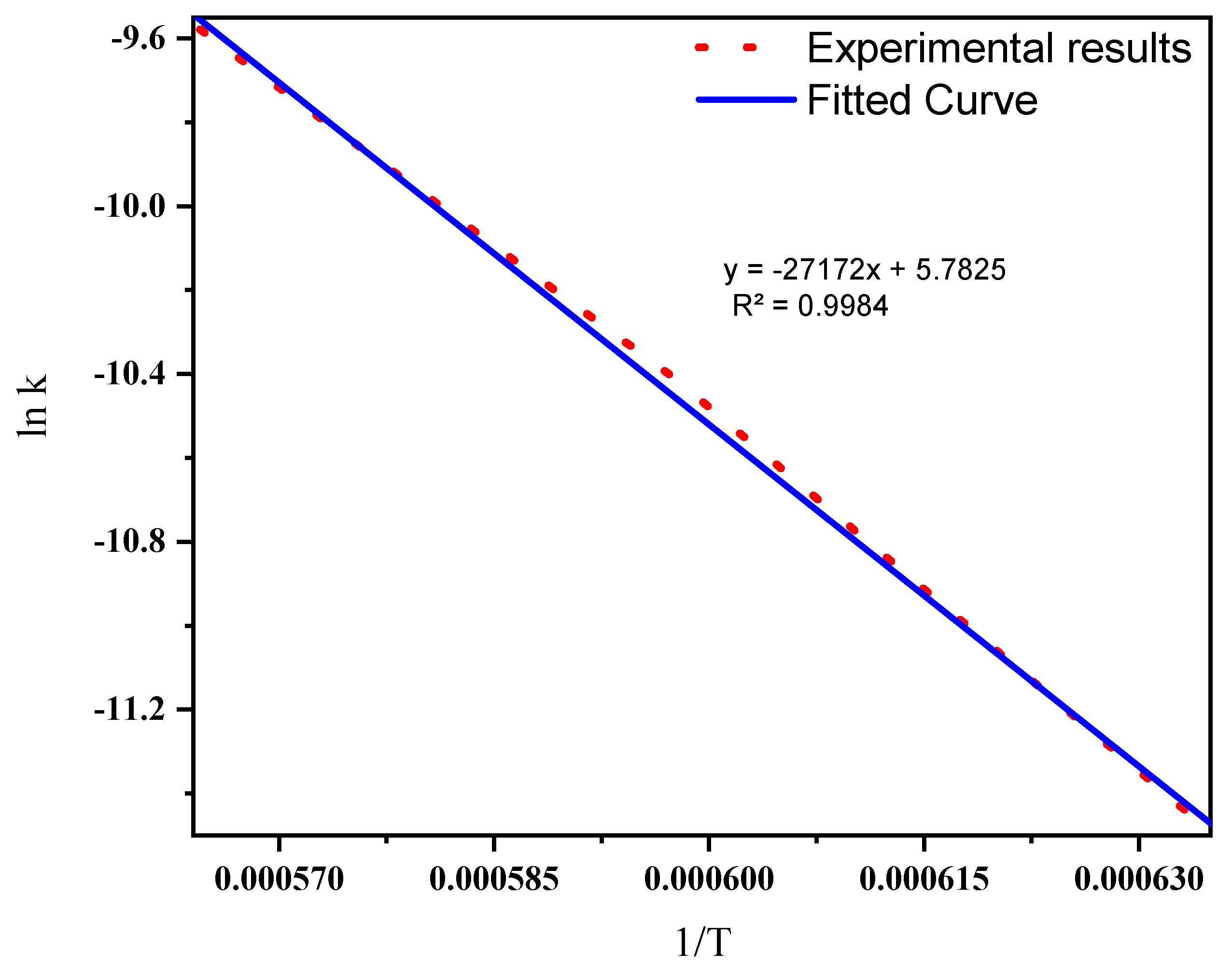
| Condition | No. | Mathematical Model | G(x) | |
|---|---|---|---|---|
| Phase boundary/interfacial reaction controlled | 1 | P1 | Contracting area/cylinder | |
| 2 | P2 | Contracting volume/sphere | ||
| Diffusion | 3 | D1 | 3D diffusion-Jander | |
| 4 | D2 | 3D diffusion-Ginstling–Brounshtein | ||
| Reaction order | 5 | R1 | First order | |
| 6 | R2 | Second order | ||
| Avrami-Erofeev/Nucleation | 7 | N1 | n = 2 | |
| 8 | N2 | n = 3 | ||
| C | Si | O | Total |
|---|---|---|---|
| 63.88 | 31.06 | 5.06 | 100.00 |
| S. No. | Temperature (°C) | Average Activation Energy (kJ mol−1) | Method | Ref. |
|---|---|---|---|---|
| 1 | 800 | 163.01 | Friedman | [45] |
| 156.45 | Kissinger–Akahira–Sunose | |||
| 159.22 | Flynn–Wall–Ozawa | |||
| 2 | 170–380 | 42.5 | Coats–Redfern n = 1 | [24] |
| 380–503 | 126.5 | Coats–Redfern n = 1 | ||
| 380–503 | 125.1 | Freeman and Carroll | ||
| 3 | 359 | 22.48 | ||
| 520 | 2.97 | Coats–Redfern n = 1 | Current work | |
| 717 | 6.6 |
| Model | Temperature (°C) | |||||
|---|---|---|---|---|---|---|
| 1300 | 1400 | 1500 | ||||
| Linearised Equation | R2 | Linearised Equation | R2 | Linearised Equation | R2 | |
| P1 | y = 9 × 10−5x + 0.0777 | 0.6963 | y = 2 × 10−4x + 0.0674 | 0.8727 | y = 2 × 10−4x + 0.1003 | 0.8644 |
| P2 | y = 6 × 10−5x + 0.0526 | 0.7084 | y = 1 × 10−4x + 0.045 | 0.8853 | y = 2 × 10−4x + 0.0666 | 0.8865 |
| D1 | y = 1 × 10−5x + 0.0033 | 0.9303 | y = 3 × 10−5x + 0.0003 | 0.9901 | y = 7 × 10−5x − 0.0005 | 0.9924 |
| D2 | y = 1 × 10−5x + 0.0032 | 0.9196 | y = 2 × 10−5x + 0.0008 | 0.9862 | y = 6 × 10−5x + 0.002 | 0.9828 |
| R1 | y = 2 × 10−4x + 0.1629 | 0.7323 | y = 4 × 10−4x + 0.1342 | 0.9084 | y = 7 × 10−4x + 0.1932 | 0.9256 |
| R2 | y = 3 × 10−4x + 0.1782 | 0.8002 | y = 6 × 10−4x + 0.1223 | 0.9614 | y = 1.5 × 10−3x + 0.099 | 0.9927 |
| N1 | y = 1 × 10−4x + 0.0815 | 0.7323 | y = 2 × 10−4x + 0.067 | 0.9084 | y = 4 × 10−4x + 0.0966 | 0.9256 |
| N2 | y = 7 × 10−5x + 0.0543 | 0.7323 | y = 1 × 10−4x + 0.0447 | 0.9084 | y = 2 × 10−4x + 0.0644 | 0.9256 |
| Materials | Temperature (°C) | Activation Energy (kJ mol−1) | Ref. |
|---|---|---|---|
| Coke breeze | 1400–1500 | 550 | [43] |
| Charcoal | 1350–1450 | 544 | [49] |
| Carbon black | 1575–200 | 382 | [50] |
| Carbon black | 1300–1600 | 287 | [51] |
| Carbon black | 1500–1800 | 251 | [52] |
| Mixed ASR and waste glass | 1300–1500 | 225.9 | Current work |
Disclaimer/Publisher’s Note: The statements, opinions and data contained in all publications are solely those of the individual author(s) and contributor(s) and not of MDPI and/or the editor(s). MDPI and/or the editor(s) disclaim responsibility for any injury to people or property resulting from any ideas, methods, instructions or products referred to in the content. |
© 2023 by the authors. Licensee MDPI, Basel, Switzerland. This article is an open access article distributed under the terms and conditions of the Creative Commons Attribution (CC BY) license (https://creativecommons.org/licenses/by/4.0/).
Share and Cite
Hemati, S.; Biswal, S.; Pahlevani, F.; Udayakumar, S.; Sahajwalla, V. Degradation Kinetics of Automotive Shredder Residue and Waste Automotive Glass for SiC Synthesis: An Energy-Efficient Approach. Crystals 2023, 13, 1183. https://doi.org/10.3390/cryst13081183
Hemati S, Biswal S, Pahlevani F, Udayakumar S, Sahajwalla V. Degradation Kinetics of Automotive Shredder Residue and Waste Automotive Glass for SiC Synthesis: An Energy-Efficient Approach. Crystals. 2023; 13(8):1183. https://doi.org/10.3390/cryst13081183
Chicago/Turabian StyleHemati, Sepideh, Smitirupa Biswal, Farshid Pahlevani, Sanjith Udayakumar, and Veena Sahajwalla. 2023. "Degradation Kinetics of Automotive Shredder Residue and Waste Automotive Glass for SiC Synthesis: An Energy-Efficient Approach" Crystals 13, no. 8: 1183. https://doi.org/10.3390/cryst13081183








